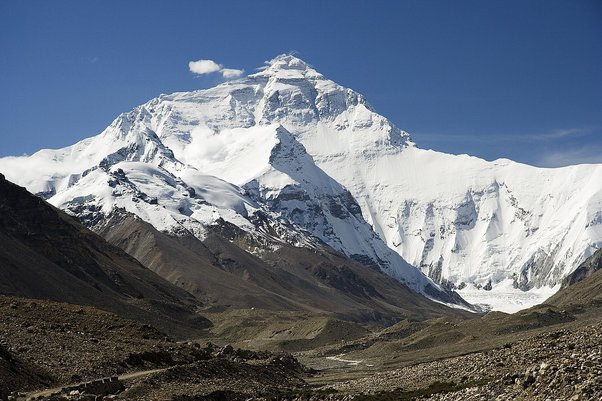Which is the most difficult way to climb Everest? Has anyone tried it successfully?
There are 18 complete routes to reach the summit through the three faces of Mount Everest:
Nepali southwest face
North face of Tibet
Tibetan eastern face or Kangshung face
The National Geographic website displays a great 3D map of 18 routes at this link. I recommend that anyone who is interested in different ways see that webpage — on the big screen. Clicking on the individual paths on their map will reveal additional information.
Photo: North face of Everest (Photo credit: Luka Galuji).
Different people may classify different routes on Everest as the most difficult, but most generally agree on the following:
Above the Kangshung Glacier, the eastern face is a dangerous beast – steep and snowy. There are still two routes mapped on it: Direct Route and Fantasy Ridge / East Ridge. None of these routes are on the National Geographic Map. They are probably the two most difficult routes on Everest.
Dangerous Neverrest Buttres (Route H on the map) and American Buttres (Route I) also climbed east. There have been only 13 summits between the two routes so far. These are definitely on the list of the most difficult routes on Everest.
Lo La Pass (Route A) is an exceptionally dangerous and difficult route. It starts from the usual base camp towards Nepal, but turns left to avoid snowfall and leads to steep snow and ice face. It joins the deadly West Ridge Root and the Hornbean Coloir. Eleven climbers were killed on this route, which had only 13 peaks. See the link below that describes an adventurous current attempt (January 2022) on this dangerous path.
The southwest face of Everest is breathtaking with a lot of exposed rocks. I remember standing at its base and looking at the vertical-hill face at 2,000 meters-positions. To this day, I still can not figure out how anyone overcame that face — although they did in full gear, tent, oxygen tank and facilities in high altitude gear, while working only in cold, thin air so far 30 climbers have reached Mount Everest via the southwest face, However 13 people died in such expeditions. The face has 3 paths, marked as C, D and E paths on the map. In this Quora answer I have provided some additional details about root C with pictures.
Direct routes to Messner Solo (Route M), South Pillar (F) and North Phase (N, O, P, and Q) are among the most difficult routes to climb Everest. Succeeded on rare occasions.
The northeastern part of Everest saw several thousand peaks. But in 2019, Ace Climbers, Corey Richards (USA) and Topo Esteban Yanese (Ecuador) tried to reach the summit by a new route. It is next to the rugged Russian cooler (Route L) on the map. They retreated at 7,600 meters. While their intended path may not be the hardest, it can also answer the question that no one has yet successfully completed.
Photo: Richards and Esteban Yanese on the northeast face of Everest (Photo credit: Keith Lodzinski)
Current Attempts by Law Pass in:
Hard-core climber Jost Kobush (Germany) is currently attempting a winter solo climb through the Loh La Pass and the West Ridge without oxygen tanks or Sherpa support. He had previously tried that route in the 2019/20 winter. The brutal Himalayan winter, with winds of more than 200kph and freezing winds of -70C, almost certainly prevented her from reaching the summit (naturally, I guess my guess was wrong).
Their direct progress can be tracked on this 3D map by their GPS tracker, locating Kobush in real time. Viewers can follow his turns in real time (climb up, take the gear uphill, and then back down to recover) and watch him climb to the summit. The map may take up to 30 seconds to load and is best viewed on a large screen.
Kobush has some photos of the Everest 2019 attempt through the Lo La Pass at this link. His image, glued to a sloping white mass like a particle of humanity, dramatically illustrates the dangers of the Himalayan environment. There is a reason it’s less successful on Everest’s harder routes.
